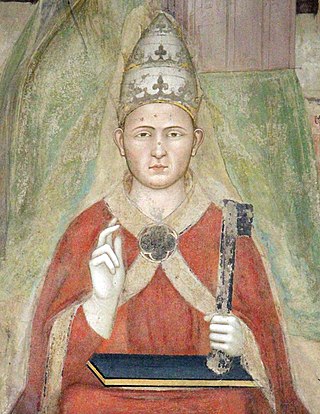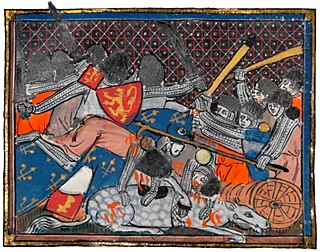Related Research Articles
Pope Benedict VI was the bishop of Rome and ruler of the Papal States from 19 January 973 to his death in 974. His brief pontificate occurred in the political context of the establishment of the Holy Roman Empire, during the transition between the reigns of Otto I and Otto II, incorporating the struggle for power of Roman aristocratic families such as the Crescentii.

Pope Boniface VIII was the head of the Catholic Church and ruler of the Papal States from 24 December 1294 until his death in 1303. The Caetani family was of baronial origin, with connections to the papacy. He succeeded Pope Celestine V, who had abdicated from the papal throne. Boniface spent his early career abroad in diplomatic roles.

Pope Clement V, born Raymond Bertrand de Got, was head of the Catholic Church and ruler of the Papal States from 5 June 1305 to his death, in April 1314. He is remembered for suppressing the order of the Knights Templar and allowing the execution of many of its members. A Frenchman by birth, Clement moved the Papacy from Rome to Avignon, ushering in the period known as the Avignon Papacy.

The Avignon Papacy was the period from 1309 to 1376 during which seven successive popes resided in Avignon rather than in Rome. The situation arose from the conflict between the papacy and the French crown, culminating in the death of Pope Boniface VIII after his arrest and maltreatment by Philip IV of France. Following the subsequent death of Pope Benedict XI, Philip pressured a deadlocked conclave to elect the Archbishop of Bordeaux as pope Clement V in 1305. Clement refused to move to Rome, and in 1309 he moved his court to the papal enclave at Avignon, where it remained for the next 67 years. This absence from Rome is sometimes referred to as the "Babylonian captivity" of the Papacy.

Year 1302 (MCCCII) was a common year starting on Monday of the Julian calendar.

Philip IV, called Philip the Fair, was King of France from 1285 to 1314. By virtue of his marriage with Joan I of Navarre, he was also King of Navarre and Count of Champagne as Philip I from 1284 to 1305. Although Philip was known to be handsome, hence the epithet le Bel, his rigid, autocratic, imposing, and inflexible personality gained him other nicknames, such as the Iron King. His fierce opponent Bernard Saisset, bishop of Pamiers, said of him: "He is neither man nor beast. He is a statue."
Robert Winchelsey was an English Catholic theologian and Archbishop of Canterbury. He studied at the universities of Paris and Oxford, and later taught at both. Influenced by Thomas Aquinas, he was a scholastic theologian.
Clericis laicos was a papal bull issued on February 5, 1296, by Pope Boniface VIII in an attempt to prevent the secular states of Europe—in particular France and England—from appropriating church revenues without the express prior permission of the pope. The two expansionist monarchies had come to blows, and the precedents for taxation of the clergy for a "just war" if it was declared a crusade and authorized by the papacy had been well established. The position of Boniface was that prior authorization had always been required and that the clergy had not been taxed for purely secular and dynastic warfare.
The Gregorian Reforms were a series of reforms initiated by Pope Gregory VII and the circle he formed in the papal curia, c. 1050–80, which dealt with the moral integrity and independence of the clergy. The reforms are considered to be named after Pope Gregory VII (1073–85), though he personally denied it and claimed his reforms, like his regnal name, honoured Pope Gregory I.

Unam sanctam is a papal bull that was issued by Pope Boniface VIII on 18 November 1302. It laid down dogmatic propositions on the unity of the Catholic Church, the necessity of belonging to it for eternal salvation, the position of the Pope as supreme head of the Church and the duty thence arising of submission to the Pope in order to belong to the Church and thus to attain salvation. The Pope further emphasized the higher position of the spiritual in comparison with the secular order. The historian Brian Tierney calls it "probably the most famous" document on church and state in medieval Europe. The original document is lost, but a version of the text can be found in the registers of Boniface VIII in the Vatican Archives. The bull was the definitive statement of the late medieval theory of hierocracy, which argued for the temporal as well as spiritual supremacy of the pope.

Bernard Saisset was an Occitan bishop of Pamiers, in the County of Foix in the south of France, whose outspoken disrespect for Philip IV of France incurred charges of high treason in the overheated atmosphere of tension between the king and his ministry and Pope Boniface VIII, leading up to the papal bull Unam sanctam of 1302.

Jean Lemoine, Jean Le Moine, Johannes Monachus was a French canon lawyer, Cardinal, bishop of Arras and papal legate. He served Boniface VIII as representative to Philip IV of France, and founded the Collège du Cardinal Lemoine, in Paris. He is the first canon lawyer to formulate the legal principle of the presumption of innocence.

The 1304–1305 papal conclave was initiated after the death of Pope Benedict XI in July 1304. The conclave took place in Perugia, the city in which Benedict had died, and proved to be a protracted affair. It ran from 10 or 17 July 1304 to 5 June 1305, and ultimately elected the non-cardinal Raymond Bertrand de Got as Pope Clement V. At the time of his election de Got was Archbishop of Bordeaux, and thus a subject of Edward I, King of England, although he was a childhood friend of Philip IV of France. Clement V's decision to relocate the papacy to France was one of the most contested issues in the papal conclave following his 1314 death, during which the minority of Italian cardinals were unable to engineer the return of the papacy to Rome. This immediately preceded the beginning of the Avignon Papacy.

In 1307, members of the Knights Templar in the Kingdom of France were suddenly charged with heresy and arrested after their leader, Master Jacques de Molay, had recently come to France for meetings with Pope Clement V. Many, including their leader, were burned at the stake while others were sentenced to perpetual imprisonment. The events in France led to a series of trials in other locations, not all of which had the same outcome.

In the 1303 papal conclave, Benedict XI was elected to succeed Boniface VIII as pope.
The Taxatio Ecclesiastica, often referred to as the Taxatio Nicholai or just the Taxatio, compiled in 1291–92 under the order of Pope Nicholas IV, is a detailed database valuation for ecclesiastical taxation of English, Welsh, and Irish parish churches and prebends.
Nicolas de Nonancourt. He was a French university Chancellor, Dean of a Cathedral, and Roman Catholic Cardinal.

The Buda heresy was a Waldensian heretical movement from 1304 to 1307 in Buda, the capital of the Kingdom of Hungary. In a political context, the heresy was a tiny segment of a wider conflict during the era of Interregnum following the death of King Andrew III of Hungary, when various claimants fought for the Hungarian throne.

In the Middle Ages, hierocracy or papalism was a current of Latin legal and political thought that argued that the pope held supreme authority over not just spiritual, but also temporal affairs. In its full, late medieval form, hierocratic theory posited that since Christ was lord of the universe and both king and priest, and the pope was his earthly vicar, the pope must also possess both spiritual and temporal authority over everybody in the world. Papalist writers at the turn of the 14th century such as Augustinus Triumphus and Giles of Rome depicted secular government as a product of human sinfulness that originated, by necessity, in tyrannical usurpation, and could be redeemed only by submission to the superior spiritual sovereignty of the pope. At the head of the Catholic Church, responsible to no other jurisdiction except God, the pope, they argued, was the monarch of a universal kingdom whose power extended to Christians and non-Christians alike.
Pierre de Mornay was a French bishop of Orleans (1288–1296) and Auxerre (1296–1306) and chancellor of France (1304–1306).
References
This article includes a list of references, related reading, or external links, but its sources remain unclear because it lacks inline citations .(December 2009) |
- N. Erickson, "A Dispute Between a Priest and a Knight", in Proceedings of the American Philosophical Society, 111 (1967), criticisms and translation.
- Thomas Renna, "Disputatio Inter Clericum et Militem", Dictionary of the Middle Ages , vol4, 1989 ISBN 0-684-17024-8
- Thomas Renna, "Kingship in the Disputatio inter clericum et militem", in Speculum 48(1973). Available online through JSTOR.